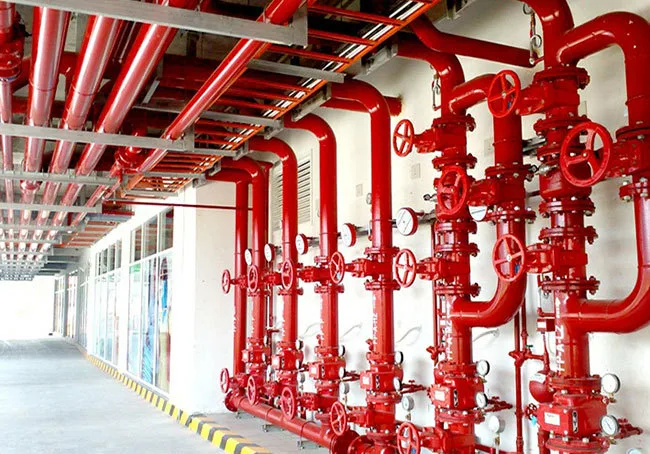A fire protection system comprises technologies and components that work together to detect and control fire hazards. This system integrates detection alarms, suppression systems, and emergency protocols to minimize risks and protect lives and property during a fire incident. Customizable to meet the specific needs of each building, these systems ensure compliance with safety regulations while enhancing the overall safety environment.
Where are Fire Protection Systems used?
- Residential and Commercial Buildings
- Industrial Facilities
- Construction Sites
- Public Spaces
- Healthcare Facilities
- Transportation Hubs
- Data centres
- Laboratories etc.
Types of Fire Protection Systems
1. Active Fire Protection Systems
Active fire protection systems require active intervention to control or extinguish a fire. These systems are essential for early intervention and include the following components:
- Fire Alarm Systems: These systems detect smoke, heat, or flames through various sensors. Upon detection, they activate audible and visual alarms to alert occupants to evacuate. Modern fire alarm systems can be integrated with building management systems for real-time monitoring and automatic notification of emergency services when an alarm is triggered.
- Sprinkler Systems: Sprinklers are installed throughout the building and activate automatically when heat is detected. They release water directly onto the fire, controlling or extinguishing it before it can spread. There are different types of sprinkler heads, such as standard response and quick response, each designed for specific applications to ensure optimal coverage.
- Fire Extinguishing Systems: These systems can be portable, like handheld extinguishers, or fixed, such as those found in commercial kitchens or server rooms. They utilize water, foam, or chemical agents to suppress fires quickly, allowing occupants to manage small fires before they escalate.
- Standpipe Systems: Found in multi-story buildings, standpipe systems provide a means for firefighters to connect hoses and access water from various levels. These systems ensure that firefighters can quickly and efficiently tackle fires in larger structures.

2. Passive Fire Protection Systems
Passive fire protection systems are designed to contain fires and restrict their spread by utilising fire-resistant building materials and architectural designs. Key components of these systems include:
- Fire Doors: Designed to resist fire and smoke, these doors help compartmentalise areas within a building, typically made from materials like steel, solid-core wood, gypsum, or fibreglass, and are equipped with self-closing mechanisms to ensure they remain closed during a fire.
- Fire Barriers and Walls: These physical structures prevent the spread of fire between different compartments, constructed from fire-resistant materials such as, steel studs with gypsum board, mineral wool insulation etc. strategically placed to create safe zones within the building.

3. Specialized Fire Protection Systems
These systems are tailored to meet the specific needs of different environments or fire risks. They include:
- Clean Agent Fire Suppression Systems: Utilizing non-toxic gases, these systems effectively suppress fires without leaving residue or damaging sensitive electronic equipment, making them ideal for data centers, museums, and archives.
- Foam Fire Suppression Systems: These systems are effective for combating flammable liquid fires, commonly used in environments such as chemical processing plants and fuel storage facilities. The foam blankets the fire, preventing oxygen from fueling it.
- Wet and Dry Chemical Systems: Specifically designed for commercial kitchens, these systems combat grease fires with specialized agents that are effective at suppressing high-temperature cooking oils and fats.

4. Detection Systems
Detection systems are important for the early warning of fire incidents, allowing for timely evacuation and response. They include:
- Smoke Detectors: These devices sense smoke particles in the air, triggering alarms to alert occupants of potential fire. Different types include ionization and photoelectric smoke detectors, each suitable for different environments.
- Heat Detectors: These detectors monitor temperature changes in the environment and activate alarms when rapid increases in temperature occur, providing an additional layer of fire detection.
- Gas Detectors: Monitoring for flammable or toxic gases, these detectors alert occupants to potential fire hazards and help prevent dangerous situations before they escalate.

5. Emergency and Evacuation Systems
These systems ensure safe evacuation during a fire emergency by providing guidance and support.
They consist of:
- Emergency Lighting: This lighting activates during power outages, illuminating evacuation routes and important areas to assist occupants in safely navigating their way to exits.
- Exit Signage: Clearly marked exit signs indicate evacuation routes and emergency exits, strategically placed throughout a building to ensure occupants can quickly and safely exit during an emergency.
- Public Address Systems: These systems allow for real-time communication during a fire incident, enabling authorities to inform and instruct occupants on evacuation procedures and other safety measures.

6. Integrated Fire Protection Systems
Integrated fire protection systems combine various fire safety components into a cohesive framework to enhance effectiveness during emergencies. By leveraging advanced technology, these systems improve detection, communication, and management of fire safety measures within a building. Key components include:
- Building Management Systems (BMS): These systems monitor and control fire safety components like alarms and emergency lighting, ensuring rapid communication and response. For instance, when a fire alarm is triggered, the BMS can automatically activate emergency lighting and notify emergency services.
- Centralized Control Panels: Serving as the hub for integrated fire protection systems, these panels receive inputs from detectors and sensors, activating alarms and suppression systems as needed. They provide data to emergency responders, facilitating quick assessment and decision-making.
- Interconnected Alarm Systems: In an integrated setup, fire alarms and smoke detectors are interconnected, triggering alerts throughout the building when one detector is activated. This ensures all occupants receive timely warnings.
- Smart Technology Integration: Many integrated systems utilize smart technology for features like real-time status updates, remote monitoring, and automated notifications to management and responders, streamlining communication.
Conclusion
Selecting the appropriate fire protection system is essential for ensuring safety in different types of buildings. By understanding the various types of fire protection systems outlined above, building owners and managers can make informed decisions that enhance fire safety.

